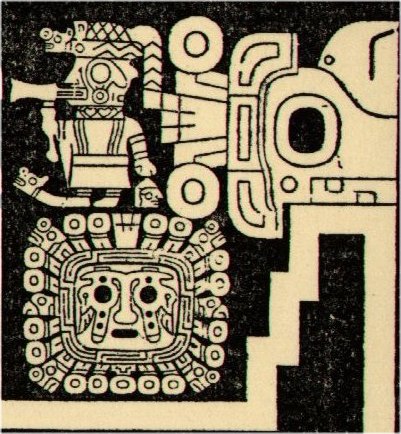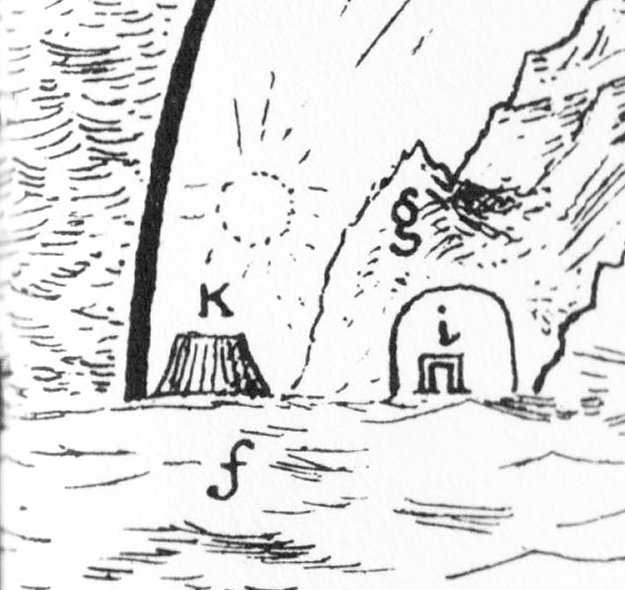|
TRANSLATIONS
The Maori knew the cat, and ngeru was one of the first words I learnt in that language:
(Ref.: Harawira) To disappear among the waves of the sea, to perish, and then the cat again. It makes one think. The needle, I suppose, must be the point of midwinter solstice. Before the reversal occurs, there must be a point of standstill. The standstill may very well be the meaning of the first part of Aa1-15:
I have noticed that there are two main variants of this glyph type (GD29, vae), open at the top (e.g. Aa8-79) or closed at the top (e.g. Ab3-34):
No more 'walking', a cut-off leg, may be the meaning of the closed variant. At Aa8-79 Metoro said ko te vae kua oho, which I translate as 'the walking leg'.
Though Metoro also used the word oho at GD29 and that may be more appropriate.
To 'put on the brakes' (hakaoho) sounds as a reasonable reading of the left part of Aa1-15. Maybe that is accomplished by the solar cat cutting of the head of the cosmis snake.
At Tiahuanaco we can (in the stone carvings on the Gateway of the Sun) see a peculiar person blowing the horn and carrying in his left hand the head of the decapitated enemy, and the time evidently is solstice. On his head he wears a mark of his function: a cat connected to the crown of the great eagle. Now I think we are prepared to make some statement about the meaning of the X area in A:
The strange marai at Aa1-14 I belive is a variant of marae, the centrally located cleared and level burial field 'in front' (rae), here of the year:
The 'four-godded theology of eastern Polynesia' may explain the four 'sun-beams' at the top of niu, together like a beacon with light in all directions (at the north - or south - pole every direction goes south - respectively north). The 3 'pods' in Aa1-14 (though normally 4 in number) may signify the 3 wives of the sun; GD21 (poporo) means darkness etc. The break after vae - expressed inside a glyph to make the signal very clear - probably means the break between old and new year. This type of signal we have met before, when discussing the meaning of Qb5-135--136 respectively Hb3-6and Pb5-11:
So, I should revise my earlier opinion, when I postulated: 1) The X area is a separate part from the day time and night time parts of the calendar. 2) The X area is connected with the day light part of the calendar. Only 1) I still believe in, while 2) no longer seems to be tenable. The X area is separate from the day calendar as such (both from the day time part and the night time part), because it describes the dark nights around midwinter solstice. The structure at the beginning of the Tahua text therefore should be revised into this pattern:
A minor adjustment (marked with red) tells us that the X glyph area is a continuation of what has been told before (presumably about the year being divided into 2 half-years, and by 4 cardinal points into 4 seasons). After the description of the regular calendrical year follows the X area describing midwinter solstice time, when the fire of the old year is stamped out and a new year is ignited. 15 is an odd number and that tells us that the story does not end with the X area. After year, half-years and quarters the next (lesser in duration) period to present should be the diurnal cycle. To conclude this chapter I think we should reread what my glyph dictionary says about niu: 1. This type of glyph appears during the five dark nights between the end of one year and the beginning of next year, the time when gods are born. "...the great high priest and monarch of the Golden Age in the Toltec city of Tula, the City of the Sun, in ancient Mexico, whose name, Quetzalcoatl, has been read to mean both 'the Feathered Serpent' and 'the Admirable Twin', and who was fair of face and white of beard, was the teacher of the arts to the people of pre-Columbian America, originator of the calendar, and their giver of maize. His virgin mother, Chimalman - the legend tells - had been one of the three sisters to whom God, the All-Father, had appeared one day under his form of Citlallatonac, 'the morning'. The other two had been struck by fright, but upon Chimalman God breathed and she conceived. She died, however, giving birth, and is now in heaven, where she is revered under the honourable name of 'the Precious Stone of Sacrifice', Chalchihuitzli. Quetzalcoatl, her child, who is known both as the Son of the Lord of the High Heavens and as the Son of the Lord of the Seven Caves, was endowed at birth with speech, all knowledge, and all wisdom, and in later life, as priest-king, was of such purity of character that his realm flourished gloriously throughout the period of his reign. His temple-palace was composed of four radiant apartments: one toward the east, yellow with gold; one towards the west, blue with turquoise and jade; one toward the south, white with pearls and shells; one towards the north, red with bloodstones - symbolizing the cardinal quarters of the world over which the light of the sun holds sway." (Campbell) 2. GD18 as a rule appears together with haga (GD36), a sign that at this time of the year sun has reached its minimum and its orbit will now bend upwards. "The Road of the Spider, which is also referred to in Hawaiian literature as ala-kuukuu, suggests the path by which the Sun spirals north to the June solstice, rising higher and higher each day in the sky of the northern hemisphere, and thence south to the equinox and the December solstice attaining a lower altitude each day, i.e., a combination of its daily and yearly motions. The symbolism is not difficult to perceive if one visualizes the motion of the Sun as continuous from day to day." (Makemson) 3. The word of Metoro, niu, alludes to a spinning top. That is clear from the function of this glyph in the rongorongo texts. "The correspondence between the winter solstice and the kali'i rite of the Makahiki is arrived at as follows: ideally, the second ceremony of 'breaking the coconut', when the priests assemble at the temple to spot the rising of the Pleiades, coincides with the full moon (Hua tapu) of the twelfth lunar month (Welehu). In the latter eighteenth century, the Pleiades appear at sunset on 18 November. Ten days later (28 November), the Lono effigy sets off on its circuit, which lasts twenty-three days, thus bringing the god back for the climactic battle with the king on 21 December, the solstice (= Hawaiian 16 Makali'i). The correspondence is 'ideal' and only rarely achieved, since it depends on the coincidence of the full moon and the crepuscular rising of the Pleiades Whereas, over the next two days, Lono plays the part of the sacrifice. The Makahiki effigy is dismantled and hidden away in a rite watched over by the king's 'living god', Kahoali'i or 'The-Companion-of-the-King', the one who is also known as 'Death-is-Near' (Koke-na-make). Close kinsman of the king as his ceremonial double, Kahoali'i swallows the eye of the victim in ceremonies of human sacrifice (condensed symbolic trace of the cannibalistic 'stranger-king')." (Islands of History) In old Babylonia the fate of the new year was determined in ... the little chamber in the east, below the surface of the earth, 'Versammlungsraum mit der Schicksalskammer', i.e. 'i' in the picture which Jensen has drawn
"Als solch ein Ort (resp. ein Gemach) im Osten des apsū [water below the earth] und im Osten der Erde an der Grenze zwischen dem sichtbaren und unsichtbaren Reiche hat der Duazag eine ganz besondere Bedeutung im Glauben der Babylonier. Er ist ... 'der Ort der Geschicke', der ki nam-tar-tar-ini = ašar šimātum. Ein Solcher konnte nur im Osten liegen. Denn die Sonne geht im Osten auf. Die Ostsonne ist Marduk. Darum bringt auch Marduk die Geschicke aus der Behausung seines Vaters Ía, dem Urwasser, hervor." "... der erste Monat des Jahres nach dem Schicksalsgemach (= Ubšugina) bezeichnet wird ... , der siebente aber d.i. der erste der zweiten Jahreshälfte nach dem im Ubšugina befindlichen Duazaga ..." The Rapanui word ora (= life) is used also as a name for the stick of a spinning top (made from the shell of a sandalwood nut) with which children make the top spin. In the Maori language niu = 'a means of divinaiton by sticks': "The sense of top lies in the fact that the bud end of a coconut shell is used for spinning, both in the sport of children and as a means of applying to island life the practical side of the doctrine of chances. Thus it may be that in New Zealand, in latitudes higher than are grateful to the coconut, the divination sense has persisted even to different implements whereby the arbitrament of fate may be declared." (Churchill 2) |
||||||||||||||||||||||||||||||||||||||||||||||||||||||||||||||||||||||||||||||||||||||





























